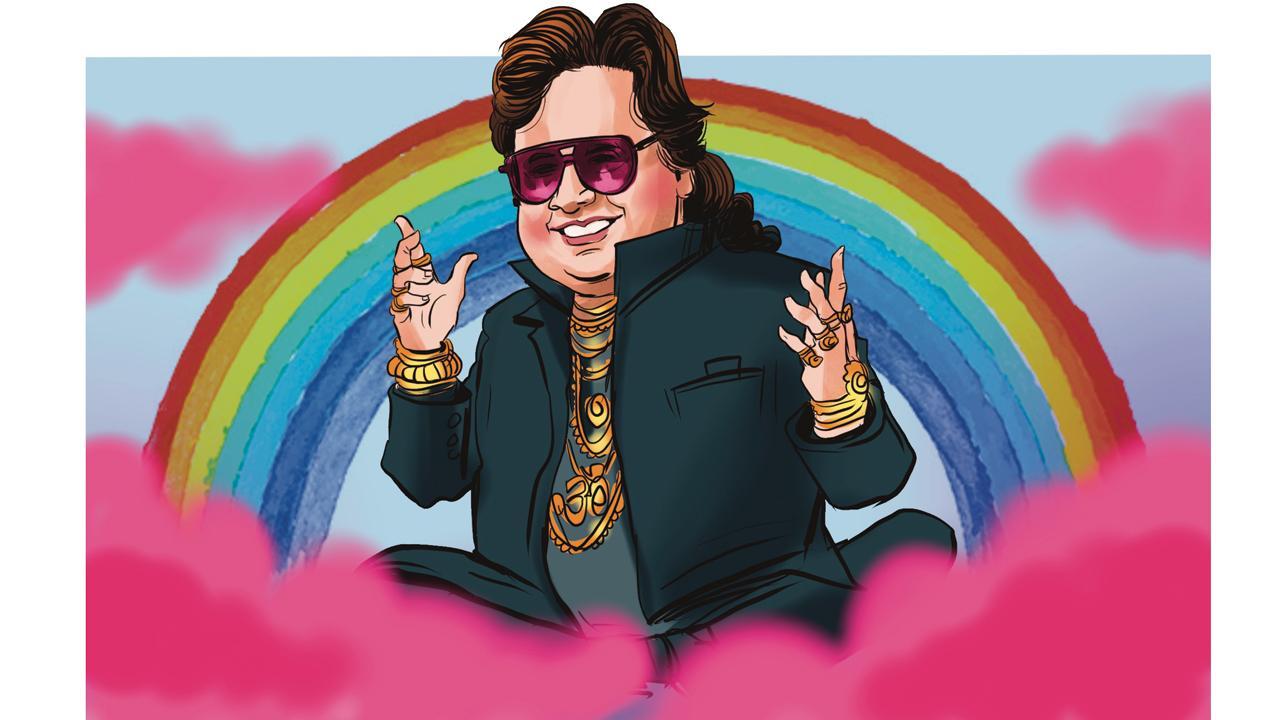Bappi Lahiri’s music put the gold in golden, festooned, like his body, with glittering aural pompoms

Illustration/Uday Mohite
![]() Many things considered infra-dig or vulgar in their time—yaniki loved by many people, who are not cultural elites—are often reclaimed by said elites in later times through the safe distance of irony and camp. Bollywood of the 1970s and ’80s, has especially suffered this condescending fate. This was partly true of the composer Bappi Lahiri who passed away last week.
Many things considered infra-dig or vulgar in their time—yaniki loved by many people, who are not cultural elites—are often reclaimed by said elites in later times through the safe distance of irony and camp. Bollywood of the 1970s and ’80s, has especially suffered this condescending fate. This was partly true of the composer Bappi Lahiri who passed away last week.
ADVERTISEMENT
It is cutely accurate that Bappi Lahiri was universally known as Bappi Da. He was indeed like that one cherubic family member who is called by his childhood pet name into old age, who lets you ‘freak out’ when charged with babysitting you, who never acquires the sobriety and predictability that allegedly define adulthood. He is always ready for merriment and you may spot him one day, as you commute through your drab grown-up life, partying on a golden cloud, pink martini in hand, rainbows glinting in dark glasses, as koi wahan dekho naache naache. The ultimate sapnon ki rani.
Bappi Lahiri straddled a cinema phase, post-Independence (that fuzzy golden era) and pre-globalisation (all family values and gritty realism sans lip sync), between Amitabh and Shah Rukh, when grown-ups were indeed not minding Hindi cinema, shaping it in the national (dominant) image; it was briefly a hormonal teen party without parental guidance where zindagi was mera gana and pyaar bina where is the chain, baby?
Bappi Lahiri’s music put the gold in golden, festooned, like his body, with glittering aural pompoms. It is of apiece with this time, where cinematic bodies are not refined, as exemplars of the nation. There is a bodily, bawdy queerness, typified by the raw sexualness of Reena Roy and Mithun Chakraborty, so pelvic, or the not-so-feminine Amrita Singh and the lumbering Sunny Deol and too hairy Anil Kapoor, or Runa Laila on television, all voluptuous bouffant and chhail chhabila singing (how sublime that Lahiri subsequently recorded an album with Runa Laila—Superuna—at the Abbey Road studios).
Bappi Lahiri seemed to have had no desire for respectability, propelled by some internal ebullience and pursuit of pleasure. He dressed like Elvis, his childhood idol, eventually developing an iconic style of gold chains and tight pants and broad collared shirts. He was perpetually happy with himself, like a child who has been showered with love and always been given the best mango.
His cheerful lifting of tunes celebrated the synthesizer’s digital exuberance, encouraging a break with certain traditions, prefiguring the eras of overt re-mixing. This lifting was a frank display of what corporate capitalism likes to pretend is not true—culture is made up of centuries of mimicking, mixing and quoting of styles and influences. Much of the discourse of IPR and so-called originality as well as the idea of ‘taste’ has a lot to do with the classes and communities who can dominate cultural production, often appropriating the rhythms and styles that have been born from community lives over centuries. They favour owners, not creators.
As ideas of heteronormativity which privilege monogamy and marriage, dismiss certain existing desires as unnatural or crass, and label some relationships illicit, so capitalism makes some things unattainable, controls the circulation and creation of art, creating piracy, and stigmatising what is ‘farji’ as low class or criminal. In a world of such bhadraloks, Bappi Da was the TC at Disco Station, who bindaas allowed ticketless folks to maaro entriyan (waaon waaaon).
Paromita Vohra is an award-winning Mumbai-based filmmaker, writer and curator working with fiction and non-fiction. Reach her at paromita.vohra@mid-day.com
 Subscribe today by clicking the link and stay updated with the latest news!" Click here!
Subscribe today by clicking the link and stay updated with the latest news!" Click here!







